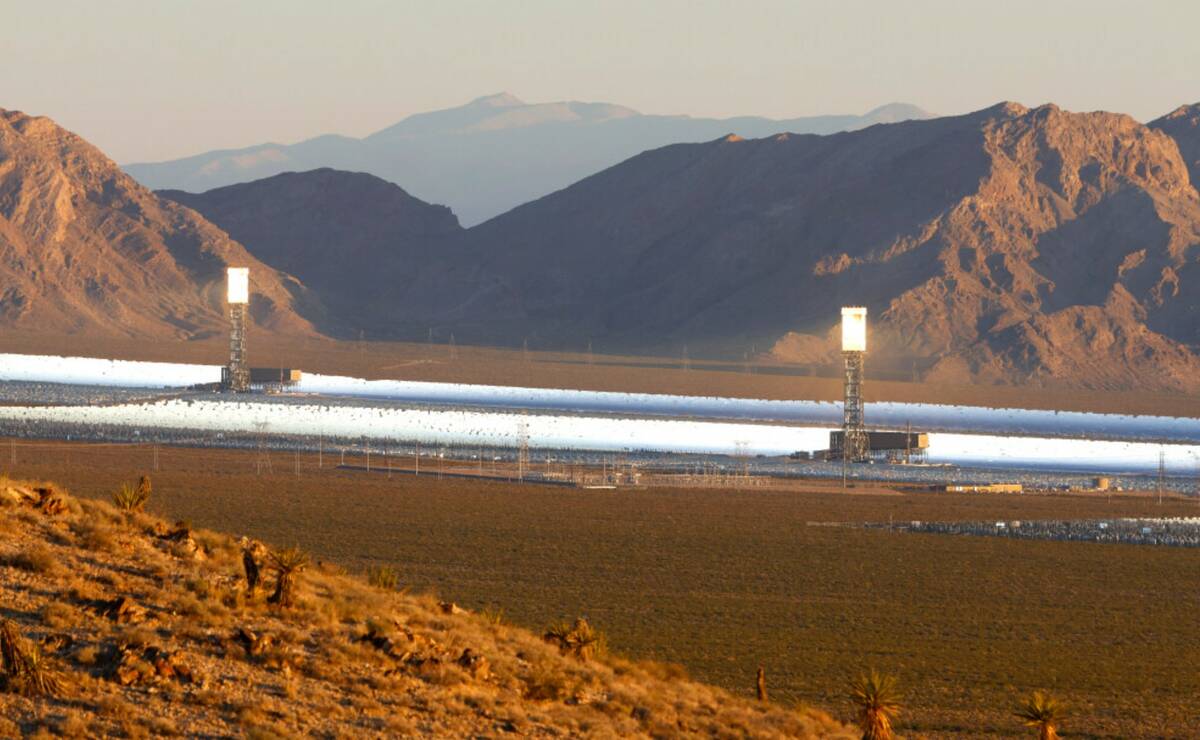Solar plant off I-15 near Las Vegas faces cloudy future; units closing — PHOTOS

The solar power generating facility that can be seen from Interstate 15, just across the state line from Primm, is set to partially shut down, according to its operators.
The Ivanpah Solar Electric Generating Facility is shutting down two-thirds of its plant after Pacific Gas and Electric Company terminated its power purchase agreement with Solar Partners, which is a joint operation from NRG, Google and Kelvin Energy, previously BrightSource, which will close Unit 1 and Unit 3 of Ivanpah, according to a news release from NRG, who also operates the plant.
PG&E contracted with NRG, who operates the plant, to provide energy to customers in 2009, and the agreement was planned to run until 2039, but PG&E decided to end the agreement with plant owners Solar Partners to save ratepayers money, PG&E said.
PG&E and Solar Partners, Ivanpah owners, have agreed to terminate their contract, if approved by the California Public Utilities Commission. PG&E customers would stop receiving power from the plant beginning in 2026, and NRG would then deactivate and decommission the units.
Unit 2 is contracted by Southern California Edison and will remain in service.
“With support from the U.S. Department of Energy, (Ivanpah owners) have finalized negotiations with PG&E to terminate their two long-term purchase power agreements, which will provide significant savings for California ratepayers,” said NRG in a statement to the Review-Journal. “Once deactivated, the units will be decommissioned so that the site can potentially be repurposed for more conventional renewable energy production.”
Employees affected by the unit closures will have the opportunity to transfer to open positions at NRG, and “the company is prepared to provide transition assistance and severance in accordance with all NRG policies.”
In 2023, Solar Partners offered PG&E the opportunity to terminate the Ivanpah Solar power purchase agreements, which is part of regulatory requirements. Ivanpah’s owners Solar Partners and the DOE finalized negotiations with PG&E on Jan. 14, which allowed for the DOE “maximize the recovery of its loans and provide savings for California ratepayers,” according to a news release from NRG.
Ivanpah history
Ivanpah opened in San Bernardino County as the world’s largest concentrating solar power project in 2014. The opening of Ivanpah marked a milestone in the United States’ growing solar and renewable energy industry.
It spans 3,500 acres and is a 386-megawatt solar concentrating thermal power plant consisting of three individual units. With costs mounting to $2.2 billion, it also received a $1.6 billion loan from the DOE, a $300 million investment from NRG and even $168 million investment from Google, the rest coming from BrightSource, now Kelvin Energy.
It was heralded as a “marker for the United States’ emerging solar industry,” according to a report from The Associated Press at the opening. At the time, only 1 percent of the nation’s power output was from solar, as opposed to today’s 3.9 percent.
“We are going to be a global leader in solar generation,” said Rhone Resch, president of the Solar Energy Industries Association at the opening, AP reported. “(The opening of Ivanpah is) a dawn of a new era in power generation in the United States.”
Concentrated thermal power plants, or CSPs, use a system of mirrors to reflect sunlight and generate thermal energy, which is then concentrated to power a steam engine. Throughout the day, 350,000 computer-controlled mirrors track the sunlight and reflect it onto boilers atop 459-foot towers to generate AC.
Nowadays, photovoltaic solar has surpassed CSP and become the dominant choice for renewable, clean energy, being more cost effective and flexible. PVs use solar cells to convert direct sunlight into energy, a much simpler process and cheaper to build and for ratepayers: CSPs cost around $0.06-per-kilowatt-hour, whereas PVs are $0.03-per-kWh.
The site has been controversial even before its inception, with regulatory and legal issues regarding protecting animals and the impact on Mojave milkweed and other plants.
Federal wildlife officials said Ivanpah might act as a “mega-trap” for wildlife, with the bright light of the plant attracting insects, which in turn attract insect-eating birds that fly to their deaths in the intensely focused light rays.
So many birds have been victims of the plant’s concentrated sun rays that workers referred to them as “streamers,” for the smoke plume that comes from birds that ignite in midair. When federal wildlife investigators visited the plant around 10 years ago, they reported an average of one “streamer” every two minutes.
Contact Emerson Drewes at edrewes@reviewjournal.com. Follow @EmersonDrewes on X. Review-Journal reporter Katie Futterman contributed to this report.